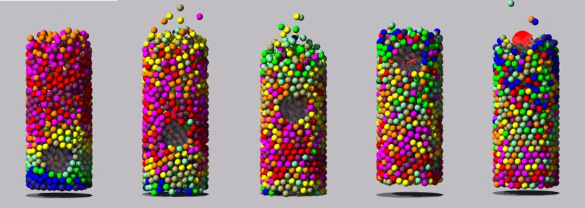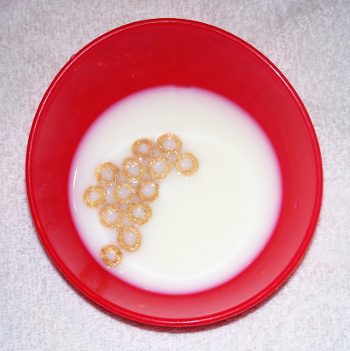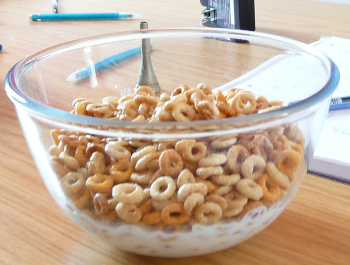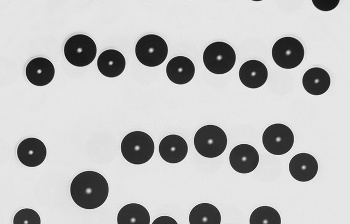The Cheerios Effect
August 25, 2016
If
mothers told their young
physicists not to play with their
food, the
youngsters weren't listening. Quite a few
discoveries have been made through
observations of food items. I've written about several on this
blog, including the
packing of
M&M candy (
Packing, November 30, 2010), the
Brazil nut effect (
Rivers of Sand, December 22, 2014), and
wine "legs" (
Oenodynamics, November 29, 2011).
The
unexpected discovery about the
lens-shaped M&M candies is that their
random packing fills space to 68%, while a random packing of
spheres achieves just 64%.
Ellipsoids of a different
aspect ratio than the M&M candies were found to fill space 78% in random packing.[1]
The well-known Brazil nut effect is the tendency for large
nuts to move to the top of a container of mixed nuts after
shaking. While noticed in cans of mixed nuts, this
phenomenon happens in any vertically-shaken, dry,
granular mixture of large and small
particles.[2-3]

Screenshots of a simulation of the Brazil nut effect. Vibration in the vertical direction causes the large object to rise in a sea of smaller objects. (Used with permission from the Granular Dynamics Update Web Site of Prof. Derek C. Richardson of the University of Maryland - College Park. For further information, see ref. 9])
One interesting food property that young physicist are likely to have seen is the
Cheerios effect, named after a popular
breakfast cereal.[4] The Cheerios effect describes the aggregation of objects
floating on the
surface of a
liquid. The individual Cheerios sit on a
meniscus that's lower than the liquid level, so neighbor Cheerios will "fall" towards each other; that is, they attract each other.

A demonstration of the Cheerios effect.
The presence of the central hole is irrelevant to the attraction, but it aids in keeping the individual pieces afloat.
(Photo by author.)
A
decade ago, a pair of
Harvard University (Cambridge, Massachusetts) physicists calculated the attractive
force between floating objects for the
idealized case of spheres.[4] Not surprisingly, the
mathematics of this
calculation is quite complex, involving a
Bessel function, something I encountered just once in a
permeability calculation. The force depends on the
density, separation, and
radius of the spheres, the
surface tension, and the
contact angle. It's easier to eat your
Cheerios than
analyze them.

Cheerios were always made from whole-grain oats, but wheat is a common contaminant of oats.
General Mills, manufacturer of Cheerios, now certifies it to be gluten-free.
(Photo by Conrad Irwin, via Wikimedia Commons.)
In further
research on the Cheerios effect
published earlier this year, physicists from
Montclair State University (Montclair, New Jersey) and Harvard University found that aggregation is enhanced when the liquid
temperature is increased. The size of the aggregate increased with temperature until all the floating particles are joined. This happens because the
viscosity and
surface tension of the liquid changes, and
convection causes liquid
flow.[5]
When you have many small particles floating on a large surface area, they don't aggregate into a single large
island. Instead, they aggregate into smaller islands separated by large voids.[6] Our
universe has a similar structure, with
stars aggregating into
galaxies separated by
voids. In one case, it's surface tension that drives the attraction, while in the other it's
gravitation.[6]
While the Cheerios effect is demonstrated as solid particles floating on a liquid, what's important isn't the liquid or solid, but the
mechanical properties of the
materials. In fact, the solids and liquids can be interchanged to have liquid
droplets showing the Cheerios effect on a solid surface. This was demonstrated by scientists at the
University of Twente (Enschede, the Netherlands), the
University of Leiden (Leiden, The Netherlands), the
Université Claude Bernard (Lyon, France),
Queen Mary University of London (London, United Kingdom), the
University of Maryland (College Park), the
Université Paris–Diderot (Paris, France), and
Eindhoven University of Technology (Eindhoven, The Netherlands).[7-8]
A similar interaction to the solid-on-liquid Cheerios effect can happen in the inverse case of liquid droplets on a solid surface. The trick to this is that the solid surface must be
soft enough to mimic how the solid particles of the regular Cheerios effect sink into the liquid.[7] This inverse effect depends on a combination of two physical effects,
capillarity and
bulk elasticity.[7]

Still image from a video of water droplets moving on a gel substrate.
(Queen Mary University of London image by S. Karpitschka.)
Interestingly, the interaction between droplets can be attractive, leading to drop–drop
coalescence, or repulsive, preventing the merger of droplets, depending on the thickness of the solid layer, a fact that might be exploited
technologically.[7] Says
co-author Lorenzo Botto, a
lecturer in the
School of Engineering and Materials Science at Queen Mary University of London,
"...The physical phenomena we have highlighted in this paper suggest ways to design surfaces that prevent fogging or control heat transfer; for instance to create car windows that are always transparent despite high humidity or surfaces that improve heat management in conditioners or boilers. By making surfaces softer or harder, and changing the thickness of the soft layer, we will be able to control how the drops coalesce and spread on the substrate."[8]
References:
- Aleksandar Donev, Ibrahim Cisse, David Sachs, Evan A. Variano, Frank H. Stillinger, Robert Connelly, Salvatore Torquato and P. M. Chaikin, "Improving the Density of Jammed Disordered Packings Using Ellipsoids," Science, vol. 303, no. 5660 (February 13, 2004), pp. 990-993.
- Heinrich M. Jaeger, "Why does shaking a can of coffee cause the larger grains to move to the surface?" Scientific American, March 24, 2003.
- M. Bose, U. U. Kumar, P. R. Nott, and V. Kumaran, "Brazil nut effect and excluded volume attraction in vibrofluidized granular mixtures," Phys. Rev. E, vol. 72, Article No. 021305, August 25, 2005.
- D. Vella and L. Mahadevan, "The 'Cheerios effect'," Am. J. Physics, vol. 73, p. 817, http://dx.doi.org/10.1119/1.1898523. Also at arXiv.
- Eric Forgostona, Leo Hentschkerb, Siobhan Soltaua, Patrick Truitta, and Ashwin Vaidya, "Thermally induced aggregation of rigid spheres on a liquid surface," Physics Letters A, vol. 380, nos. 1–2 (January 8, 2016), pp. 227-231.
- Eric Betz, "A well-known effect in breakfast cereal helps physicists understand the universe," Phys.org, September 9, 2010.
- Stefan Karpitschka, Anupam Pandey, Luuk A. Lubbers, Joost H. Weijs, Lorenzo Botto, Siddhartha Das, Bruno Andreotti, and Jacco H. Snoeijer, "Liquid drops attract or repel by the inverted cheerios effect," Proceedings of the National Academy of Sciences, Early Edition, doi: 10.1073/pnas.1601411113. A PDF file is available here, and a version is available on arXiv.
- Cereal science: how scientists inverted the Cheerios effect, Queen Mary University of London Press Release, June 14, 2016.
- Soko Matsumura, Derek C. Richardson, Patrick Michel, Stephen R. Schwartz, and Ronald-Louis Ballouz, "The Brazil nut effect and its application to asteroids," Mon. Not. R. Astron. Soc., vol. 443, no. 4 (October 1, 2014), pp. 3368-3380. A PDF file is available here, and also at arXiv.
Permanent Link to this article
Linked Keywords: Mother; physicist; food; youth; youngster; scientific discovery; observation; blog; relative density"; packing; M&M candy; Brazil nut effect; wine "legs"; serendipity; unexpected discovery; lens-shaped; randomness; random; sphere; ellipsoid; aspect ratio; nut; food packaging; container; vibration; shaking; phenomenon; granular; mixture; particle; screenshot; computer simulation; vertical direction; Granular Dynamics Update Web Site; Prof. Derek C. Richardson; University of Maryland - College Park; Cheerios effect; breakfast cereal; buoyancy; float; surface; liquid; meniscus; decade; Harvard University (Cambridge, Massachusetts); force; spherical cow; idealized case; mathematics; calculation; Bessel function; permeation; permeability; density; radius; surface tension; contact angle; Cheerios; analysis; analyze; whole-grain; oats; wheat; contamination; contaminant; General Mills; manufacturing; manufacturer; gluten-free; Conrad Irwin; Wikimedia Commons; research; scientific literature; publish; Montclair State University (Montclair, New Jersey); temperature; viscosity; surface tension; convection; fluid dynamics; flow; island; universe; star; galaxy; void; gravitation; mechanical properties; material; droplet; University of Twente (Enschede, The Netherlands); Universiteit Leiden (Leiden, The Netherlands; Université Claude Bernard (Lyon, France); Queen Mary University of London (London, United Kingdom); University of Maryland (College Park, Maryland); Université Paris–Diderot (Paris, France); Eindhoven University of Technology (Eindhoven, The Netherlands; soft matter; capillary action; capillarity; bulk elasticity; video clip; gel; S. Karpitschka; coalescence; technology; technological; co-author; Lorenzo Botto; lecturer; School of Engineering and Materials Science; fog; fogging; heat transfer; automobile; car; window; transparency; transparent; humidity; air conditioning; boiler.